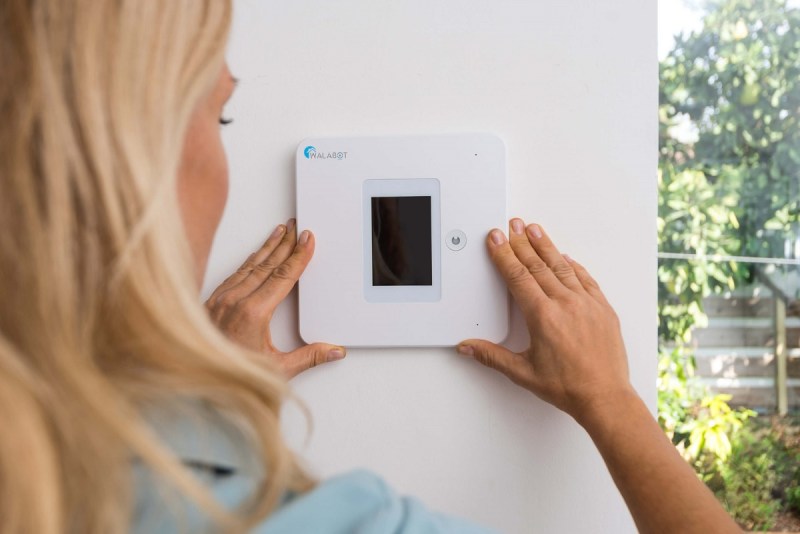As I walked 32 miles through tech’s biggest trade show, CES 2019, I kept thinking about products my 85-year-old mother could use. That’s not an easy task, as the woman — bless her heart — could not figure out how to use an iPhone. She’s got dementia and bad hearing and can barely manage the caption phone and her overly complicated TV remote.
At this year’s CES, products that help older people deal with daily life and health issues were plentiful. Such products were around in years past, but this time they came from big and small companies alike, including the likes of Intel, Samsung, and Procter & Gamble.
There were 4,500 companies across 2.9 million square feet of exhibit space at CES, and about 182,000 people from 160 countries attended, according to the Consumer Technology Association (CTA), which sponsors the show. And those companies would be wise to target older folks, according to the AARP (formerly the American Association of Retired Persons).
The AARP said in “2019 Tech Trends and the 50+” that 115 million Americans over 50 represent an enormous market for technology, and that by the end of the next decade they’re projected to spend $84 billion on tech products. And that’s just for themselves — the figure does not include all the gadgets they buy for their grandkids and others.
June 5th: The AI Audit in NYC
Join us next week in NYC to engage with top executive leaders, delving into strategies for auditing AI models to ensure fairness, optimal performance, and ethical compliance across diverse organizations. Secure your attendance for this exclusive invite-only event.
Right now, adults between 50 and 64 are just as likely to use smartphones as the average person in the U.S. (83 percent have a smartphone and 91 percent use computers). And 94 percent of people over 50 use technology to stay connected to friends and loved ones. Most of them text or email someone every day, with texting now more popular than emailing. In some cases, tech fondness rises with age: 43 percent of tech connectors in their 50s use social media daily, while half of those in their 60s do.
The AARP research found that more than one-third of the over-70 group use social media daily, and that percentage is apt to increase. In one year, use of home assistants such as Amazon Alexa or Google Home almost doubled among people 50 and older, from 7 to 13 percent. In 2018, virtual-reality devices became 44 percent more popular among those over 50.
Of course, there are 50 million people worldwide with dementia, and they’re not going to be as tech savvy. For these individuals, a caregiver might be more likely to operate the technology for them. But there’s a wide range of technologies that could be useful for older people, from self-driving cars to fall detection monitors.
Last year, a scattering of startups were addressing tech for older people, among those Hip’Air, which had air bags that could protect people from falls. But this year seemed different. It was as if one of the obvious things about demographics — that the baby boomers are going to need a lot of tech to help them as they age — had finally sunk in.
Here’s a sample of 10 of products from CES 2019 that are aimed at older users.
Flint Rehab’s FitMi
When people have a stroke, they often need extensive rehabilitation over several years. But insurance often won’t cover that kind of treatment, and so recovery is left up to each individual survivor. The FitMi is a gamified rehab tool that lets users recover at home through therapist-recommended full-body rehabilitation exercises. It uses a trackable puck to get survivors to do simple motions over and over, and it measures progress on a computer.
“There’s a real push in the digital health space,” said Flint Rehab CEO Nizan Friedman in an interview. “For us, it’s really important to empower the survivor. The current practice is to send a survivor home with a sheet of paper with exercises on it. That’s absolutely insane.”
Flint Rehab also makes the MiGo tracker to track activities designed for stroke survivors, and it created the MusicGlove, which teaches stroke survivors how to regain use of their fingers. The gamification and social sharing of the tracked results help the user stick with the exercises. The woman in the video above, Tina Orkin, suffered a stroke 2.5 years ago. She said she used FitMi to regain control of her muscles, as it gave her increasingly difficult exercises to do.
“It’s something I can do on my own,” Orkin said. “The key to stroke recovery is repetition. If you get stronger, it gives you more and more [exercises].”
Vayyar’s Walabot Home
Vayyar’s Walabot Home detects motion. I’m still trying to make this product work, as it uses promising radio wave detection — rather than intrusive cameras — to track whether someone has fallen. It is designed to detect falls within the perimeter of a room in an elderly person’s home. I put it in my mother’s room, but it sent 12 false alarms to my smartphone in a day. After Vayyar‘s support team did some calibrations and clarified what to do with it, the number of false alarms went down.
I put it up near an electrical outlet, thinking it would cover a large space in my mother’s home. But it’s meant to be placed in a bathroom, covering a small space. The company widened the range and adjusted the product, but I think it would have benefited from more testing. I’m working with Vayyar to see if it can really work as advertised. I met with them again at CES and they explained part of the problem, which seems like something that can be solved. I like the idea, but I’ll report back when I know more.
The product addresses a serious problem. Roughly every 11 seconds, an older adult is treated in the emergency room for a fall, according to the National Council on Aging. Cherry Labs has something similar, using a camera for fall detection. The problem there is that some people won’t want a camera watching them.
Zvox’s VoiceBuds

Above: Tom Hannaher is founder of Zvox Audio.
Hearing aids are in need of disruption. My mother paid nearly $5,000 for her latest pair from Hearwell, and we had to visit an audiologist to get them. In her case, the appointment with the audiologist paid off, as she identified the proper hearing levels for each of my mother’s ears.
But not everyone has the kind of money to access this type of care, nor does everyone have the type of problem that requires an audiologist. Senator Elizabeth Warren (D-Massachusetts) was able to pass a bill that could make hearing aids cheaper and much easier to buy, and Zvox Audio is offering $300 over-the-counter devices that it, for now, calls VoiceBuds.
These devices have two microphones that enable better hearing, noise cancellation for places like restaurants, and a VoiceBud app that you can use to control volume and listening modes and check on the battery status. These features are often found in devices that cost more than $600. The app also offers a way to turn down the sound before really loud noises reach the user’s ears.
I also ran into another company, Nuheara, at CES that was launching its IQBuds. Those were targeted at younger people who don’t mind having conspicuous ear buds in their ears. It has a hearing assessment that can identify people who are “pre-hearing aid” and need a hearing boost.
DFree bladder monitor
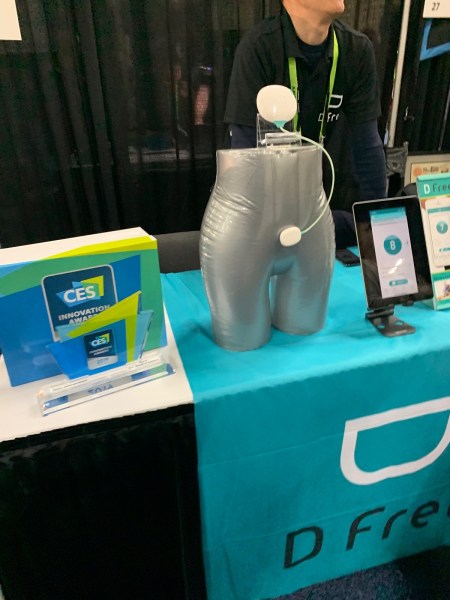
Above: DFree is a wearable that predicts when you need to go to the bathroom.
DFree has a wearable with an ultrasound sensor that can detect exactly how much fluid you have in your bladder. It can calculate what percentage of your bladder is full, and it will tell you when you are likely to need to go to the bathroom. This is important for people who have challenges with continence.
DFree notifies you via your smartphone when your bladder is half-full and you should start thinking about where to find a bathroom. That way, you are aware of the situation and less likely to have an accident. You can set the notification threshold so you have enough time to reach a facility. It can also record the average time between your bathroom visits. You have to attach it with medical tape and ultrasound gel, which is a little cumbersome. But it probably beats worrying about an accident or having to wear an incontinence diaper.
ElliQ
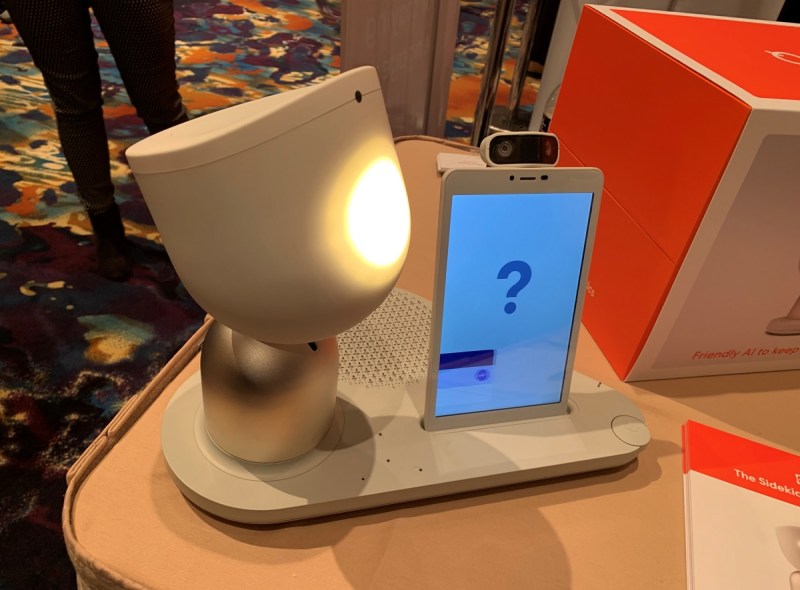
Above: ElliQ is a robot that uses AI to communicate with senior citizens.
ElliQ reminds me of that Pixar lamp character. The robot has a friendly personality, with a bobbing head and a chatty voice, and is like a robot caretaker for the elderly.
Intuition Robotics’ ElliQ comes with a tablet that an older person can also use to communicate via video calls. The device has Amazon Alexa smarts, and it can detect air quality and temperature. The idea is to help an elderly person feel less lonely and more able to live on their own for a longer time.
It is available for preorder and will ship in the middle of the year.
CarePredict
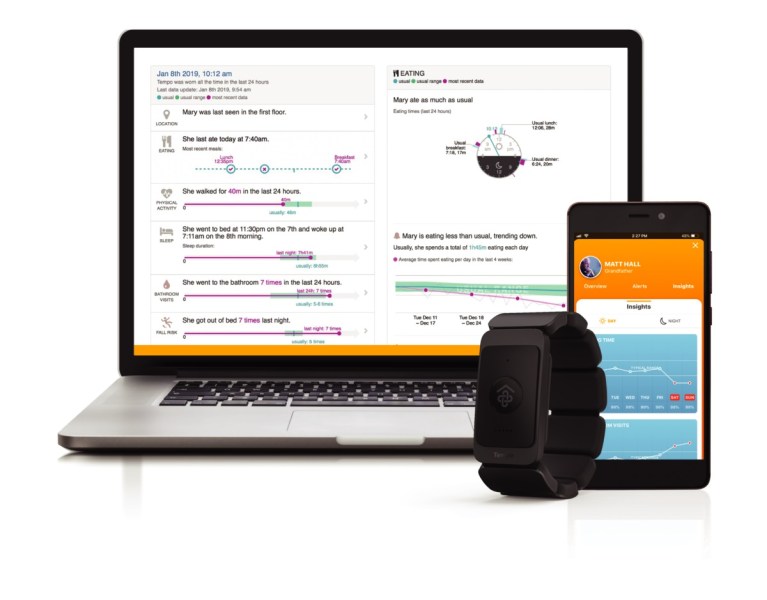
Above: CarePredict keeps you informed of your elder’s activities.
CarePredict Home uses machine learning, smart wearables, and kinematic analysis to quantify the daily activities performed by a senior citizen. It can predict health conditions, including increased risks of falls, depression, and even urinary tract infections.
It collects a lot of data on activities and behavior, including eating, walking, grooming, bathing, and going to the bathroom. It applies deep learning neural networks to this data to surface insights that can warn a caregiver about potential problems.
For instance, it can tell if the older person has changed their gait or might be dehydrated.
Intel facial expression-controlled wheelchair
Intel showed off a motorized wheelchair that can be controlled by facial expressions, rather than a joystick. It uses artificial intelligence and Intel’s RealSense cameras to detect expressions. I sat in the chair and they told me to make different expressions, like blowing a kiss to move the chair forward or opening my mouth to stop the chair. It was easy to do, and for the most part, the cameras correctly deciphered what kind of expression I was making.
The Wheelie 7 wheelchair was built in partnership with Hoobox Robotics. It can handle as many as 10 facial expressions. A caregiver can set up the expressions on an app and link them to chair movements. It works in a range of lighting situations, from sunlight to dim light.
Samsung Bot Care
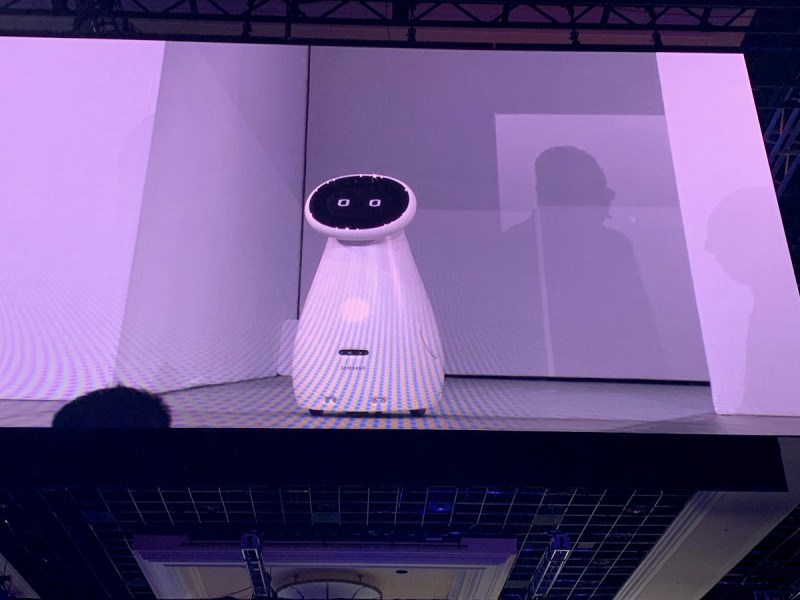
Above: Samsung Bot Care is a robot that monitors your health.
Samsung Bot Care does what many other devices do, but it comes in the form of a friendly robot. It can measure a user’s blood pressure, heart rate, respiration, and sleep state. It also reminds you when to take your medicine, and it can be viewed by an elder as a kind of companion. The bot can recommend exercise routines, offer yoga lessons, or even call 911 for you.
Omron HeartGuide

Above: The Omron HeartGuide reads your blood pressure.
As I said last year, I’ve been waiting a long time for a wearable blood pressure monitor that could prevent heart attacks. Medical giant Omron Healthcare took a step in that direction with its latest version of the Omron Healthguide, a wearable blood pressure monitor you can wear as a wristwatch that delivers clinically validated accuracy.
Omron is finally shipping the device, starting next week, for $500. Its battery can last for days, though that depends how many times you take your blood pressure. You can also use it to track fitness, monitor your sleep, and get notifications.
The Japanese company has also created a digital platform to track and store heart health data and easily share it with your physician. Many companies have shied away from adding such a feature to heart rate monitors because of concerns about regulatory approval. But Omron has received FDA approval.
It has an inflatable band inside the wristband and can periodically inflate and then capture your blood pressure at different times in the day. It can do so in your sleep, as irregular blood pressure during rest can be an indicator of a serious health issue. There were other wearables at CES that did things like capture ECG data. Now all we need to do is apply AI to this data so it can be used to predict heart attacks. Various companies are talking about this kind of technology, but it would be great to get it into a device that is this affordable.
BrainTap
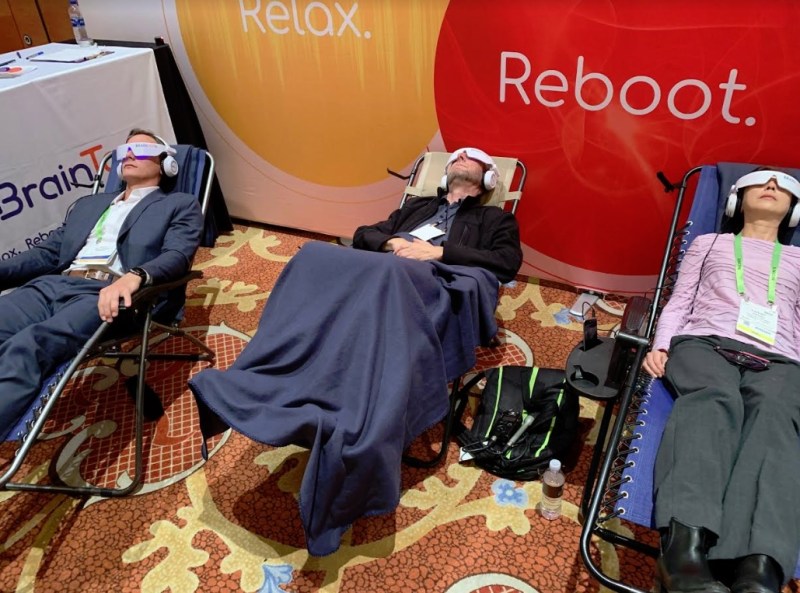
Above: BrainTap’s headset is designed to make you relax.
BrainTap uses mindfulness technology that gives off sounds and directs flashing lights at your eyelids while you rest for 10 minutes or so. I tried it out at CES 2019, and I felt refreshed, though I’m not sure whether that was because I simply lay down and closed my eyes for 10 minutes.
Now it’s available as a subscription-based mobile app, the BrainTap Pro. It aims to help you relax, reboot, and revitalize, said Patrick Porter, the doctor behind the technology, in an interview. His goal is to help people with sleep, stress, energy, and other lifestyle improvements.
There were a number of other devices I didn’t get to see or spend much time with. These include self-driving cars that can take elderly people who no longer drive to their destination, Chronolife’s smart T-shirts, Kepler Vision Technologies, the Whill autonomous wheelchair Model Ci, GrooveX Lovot, the Hupnos anti-snoring sleep mask, the Hyundai car with robot legs, Hip’Air, E-Vone fall detection, and the Invoxia portable Alexa speaker.
